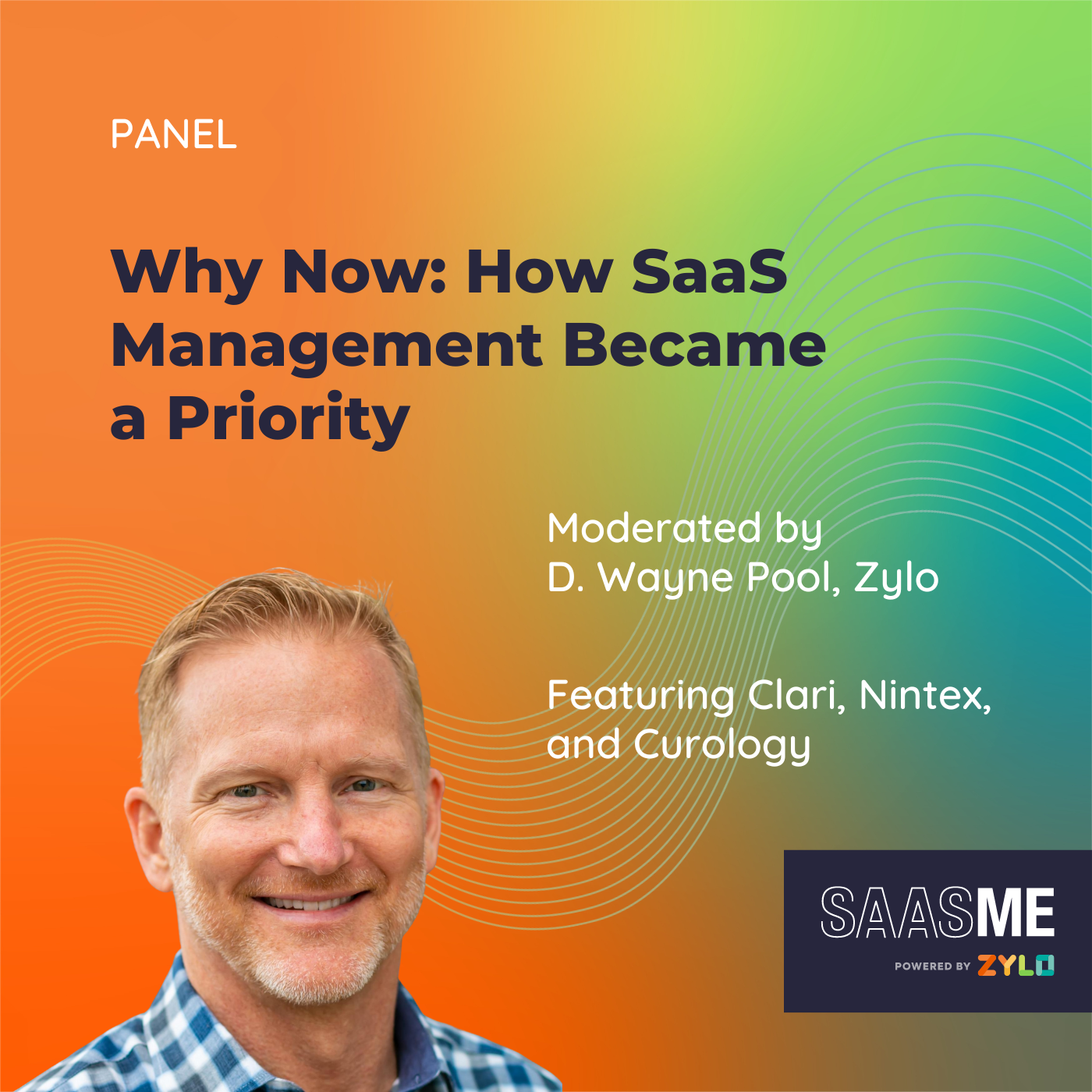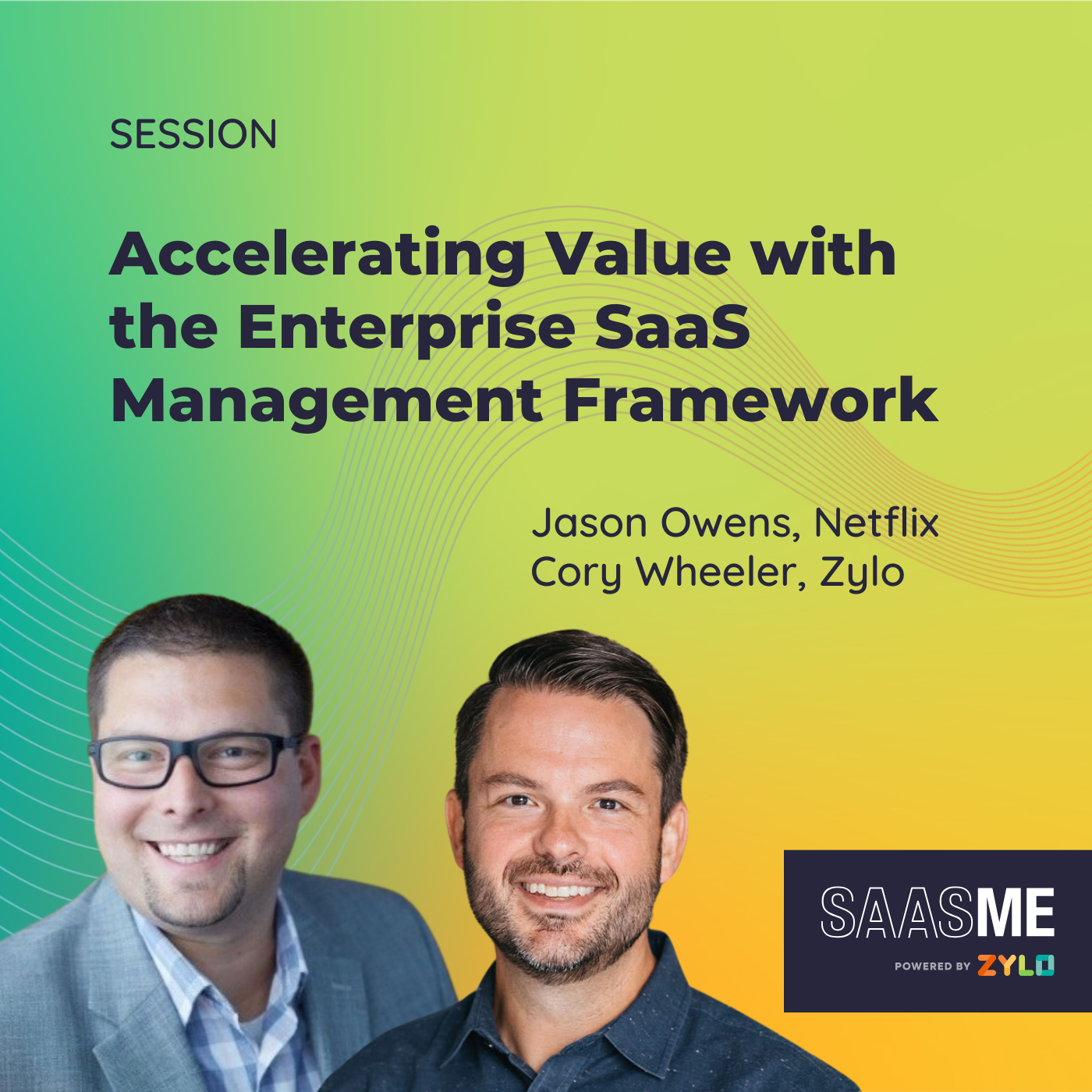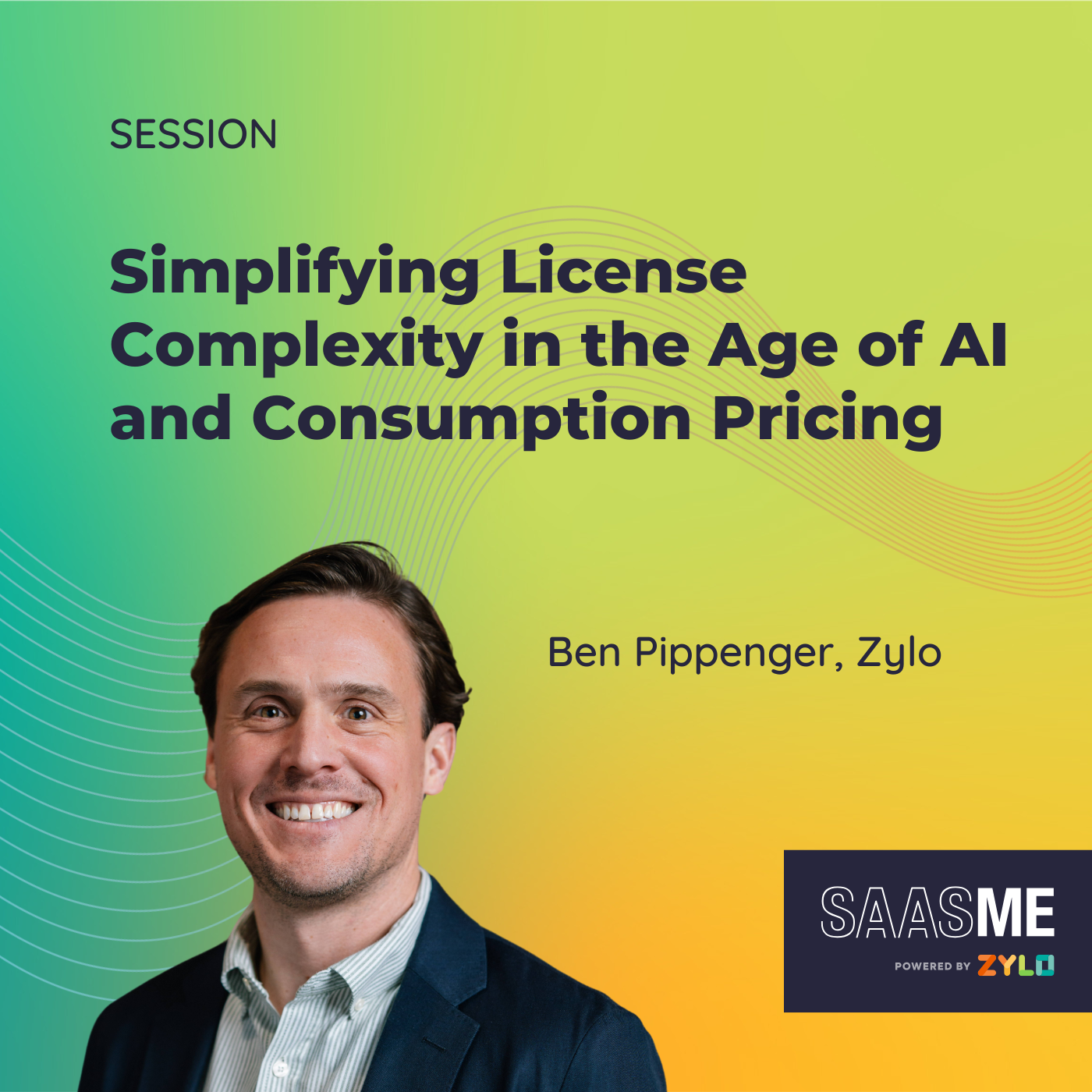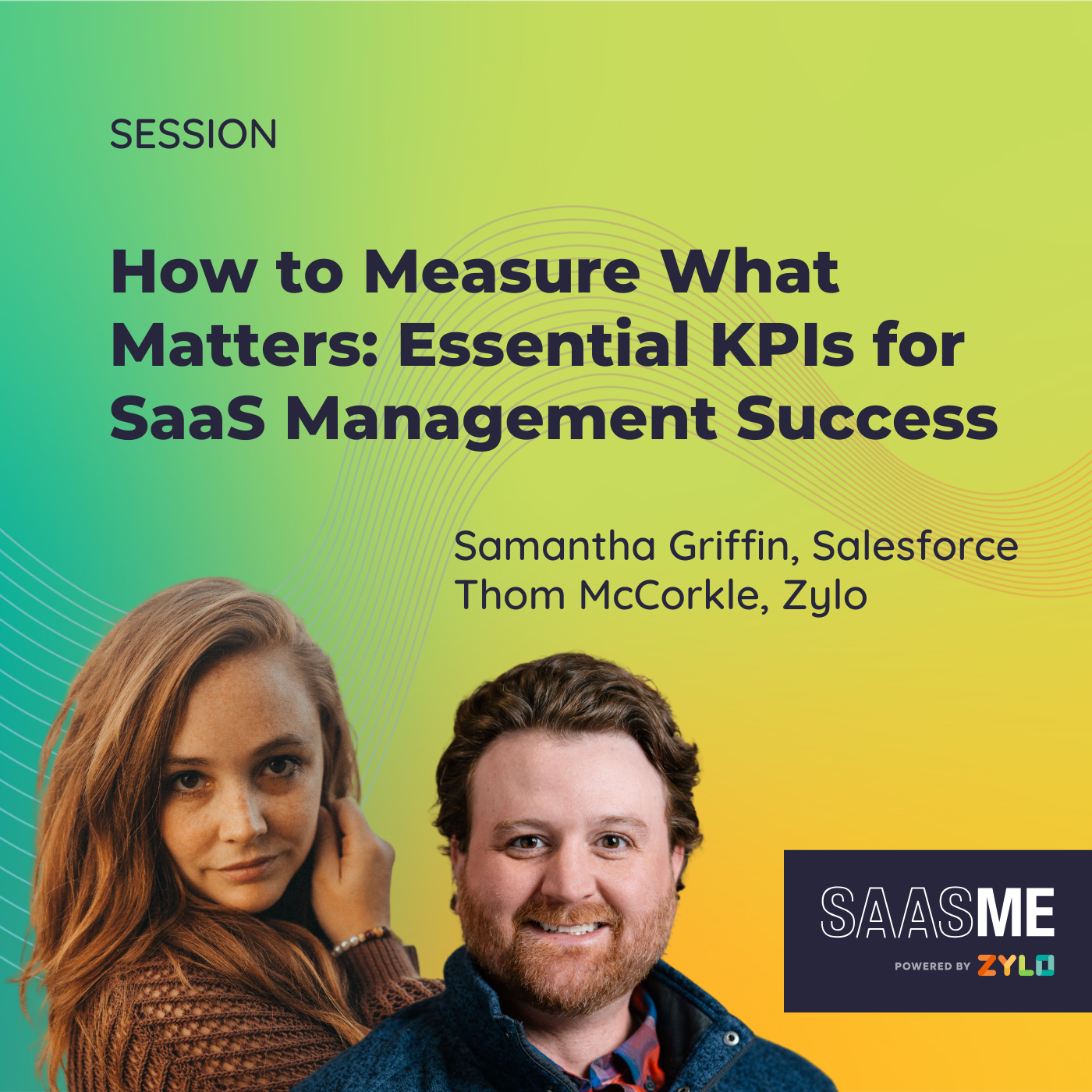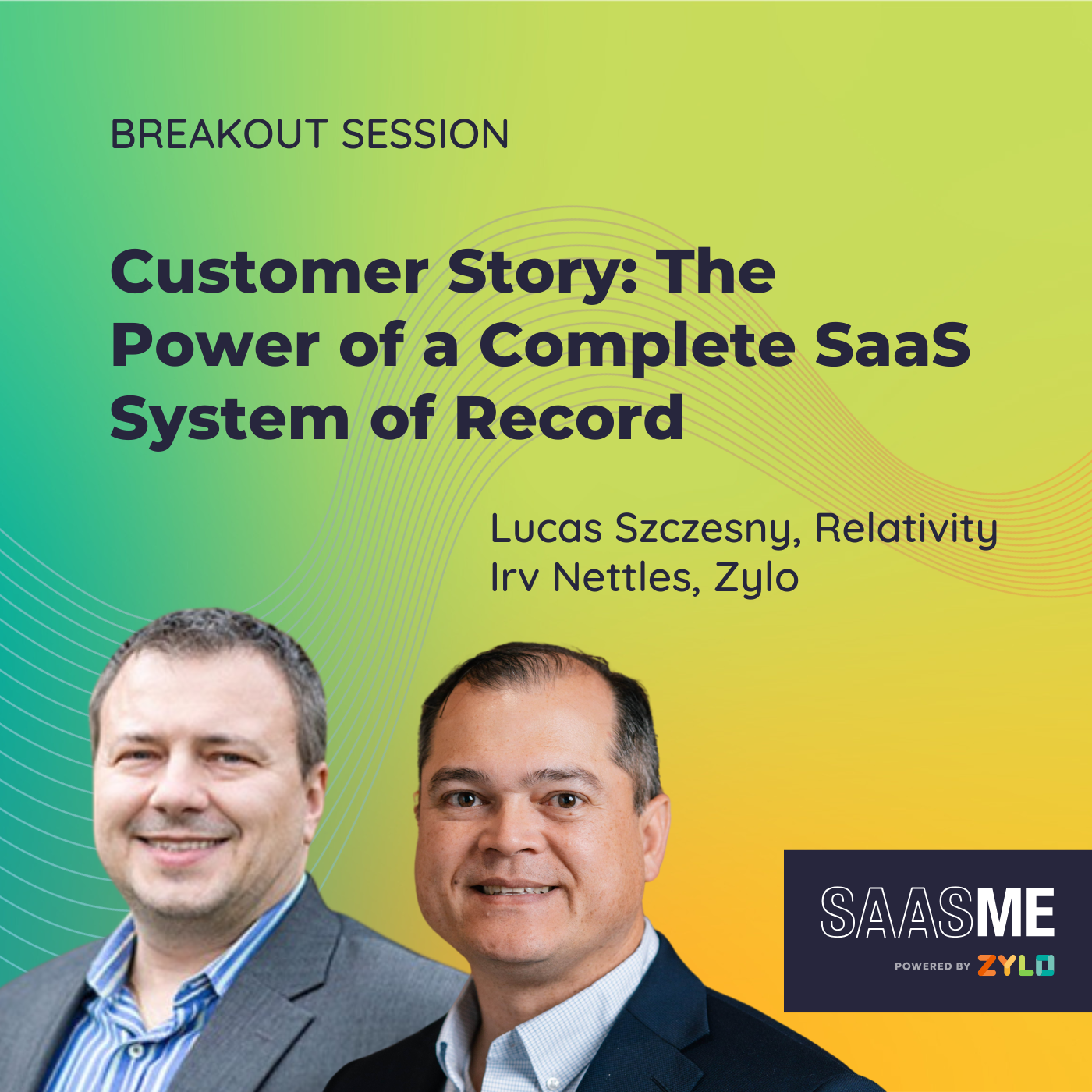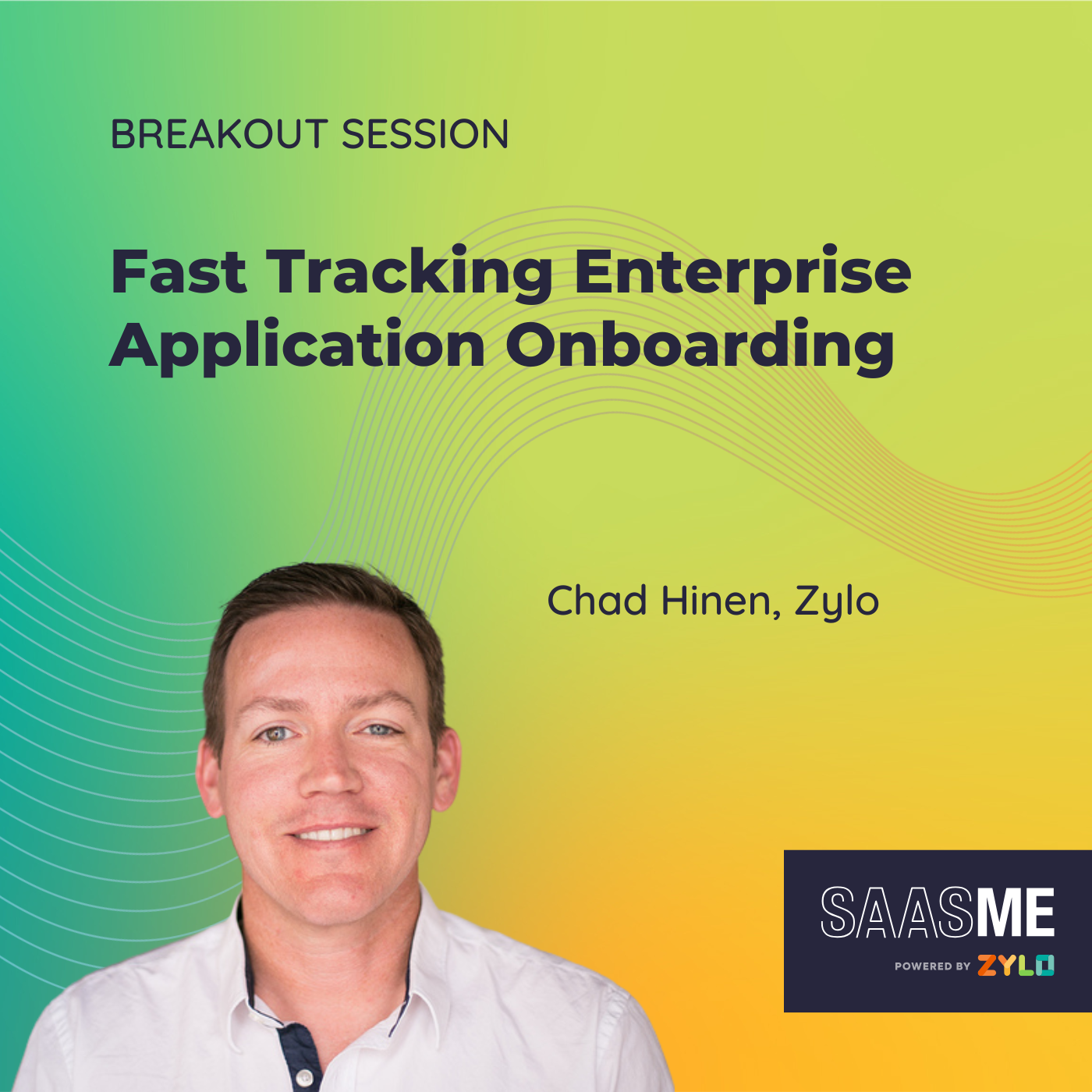Why Now: How SaaS Management Became a Priority
- 0.5
- 1
- 1.25
- 1.5
- 1.75
- 2
D. Wayne Poole: All right. Good afternoon everybody. I'm Dwayne Poole, chief operating officer here at Zylo. I am privileged and proud to be joined by some very good customers of Zylo and we are here because we are answering the question why now and why SaaS management has become a priority. Let's just get us started with some intros. Partha, Steve, Tesla, if you guys could all introduce yourselves and your role, of course it says on the screen, but then as importantly how SaaS management is related to your role. Partha, We'll start with you.
Partha Ray: Thanks DP. Hi everyone. I'm Partha, I'm the director of business applications at Nintech. And I've been with the company for about 11 years now and I started off in a business analyst role and really started to implement all of the SaaS applications as we went through the growth journey within the company. So as a result, it felt only natural for me to eventually be able to take charge of these applications as well. And from a SaaS management point of view, working with our finance team to make sure we've got the right stack at the right time for the right price, that's a key focus for me and my role.
D. Wayne Poole: Perfect. Thank you. Par, let's go to you, Steve.
Steve Gentry: Yeah, so I am our chief security officer here at Clarity. I have the security and privacy, but also importantly the IT organizations including BIS apps that roll into my organization. So we are looking at it across the whole procurement stack about not only how do we bring apps in, how are we enabling our users, how is this connected to getting users the data they need when they need it, wherever they need it, but also looking at this privacy and security implications of the data tech stack that we've got.
D. Wayne Poole: Gotcha. And Tesla.
Tassilo Festetics: I'm the CFO at Curology. I also moonlight as our CTO from time to time. And I came out of an organization I was working for, I was a ... for a very long time that's very cost conscious. And so for me, management of SaaS was kind of a clear priority just because we wanted to do more with less basically.
D. Wayne Poole: Yeah. What a great segue. Thank you guys, all three of you. First of all, thank you for taking the time out of your day. I know your time is valuable and certainly Zylo appreciates it and so do the millions of SaaS attendees that are live online here and what they're all waiting on the edge of their seat to hear is what triggered it. What really triggered the whole move towards SaaS management even before Zylo potentially. But what was it? I'll start with you, Steve. What really made it happen?
Steve Gentry: So for us is we are trying to get a handle on our redundancy. We're a SaaS first company. The only thing we have that runs on- prem is our Zoom room equipment and the routers and switches for our offices. Everything else is beyond court. Knowing that we have that beyond court model, this is even prior to the pandemic, looking at the redundancy as we've grown up as a company over the last 10 years, how have we bought applications? And then we had a fantastic head of procurement join us and being able to collaborate with her and get a handle on things, start looking at redundancy. So it was that we need to get better even prior to the downturn of the economy, get better on our spend, but also how do we know which tools to get to our users? We had 11 project management tools. How are our people collaborating with inside their own company from one team to the other? Great, product has a sauna that they're using, finance has Smartsheets so you've got to collaborate. Which tool are they using? How are we doing your redundancies? So it was a maturity aspect as a company and not even directly related to the finance, but of course as the economy tightened up, being able to drive that and make that a secondary process as a two time Zylo customer for me, as we were looking at ways to get a handle on this and the finance team come to me with spreadsheets going, Hey will you fill this out? It's like, Oh God, no, never going to do that. I'm too lazy to want to do that work, I want to automate things. Automation is not because I'm technically savvy, automation is done because I'm lazy and I want my team not to have to do work that they could have automated or could have written scripts for or bought software for. And so having the software in place, Zylo giving us a lot of data that I can then feed out to other individuals and driving that process in the company, getting away from the spreadsheet management and getting finance to see the value of it, was that big push for us of let's stop doing manual. You want to get ahold of things. Instead of a point in time solution, let's look at it in real time as it goes through. So that was our ... being more mature as a company.
D. Wayne Poole: Perfect. Spreadsheet's not getting it done and people wanting more up- to- date information. I'm sure there's a lot more than that. We'll get into. Tesla, how about you? I know that you've come into it. I think Curology was already using Zylo when you got there, so it might just be a little bit of a restart almost, if you will, when you came in changeover in management. What was it for you that you saw in Zylo or maybe even comment on how you've kind of pushed it forward?
Tassilo Festetics: I think we didn't use it really to the extent that we should have used it at the beginning. And I think we changed a lot since then. There are many, many more, but the things that really helped is obviously for example, user management. So the point is for a lot of these applications, you have hundreds of people provisioned that when you then look into it, there's 30 people who use it in the last three months. And then sometimes you're too polite, you're like, Okay, well let's send these other 180 people on email and ask them if they're using it, or maybe let's just turn them off if they haven't been there for three or four months. And Zylo gives us that visibility. Also, there was a lot about redundancy. So even small companies, you buy a lot of the same product, like project management softwares. I think we had six, which again, everybody's like, Well, but it's$15, 000, it's $20,000. Yeah, but you do that five times and it's 100 000 that you could basically just take out and basically have somebody consolidate it. And then obviously pricing is something where you guys were also super, super helpful in terms of helping us get all that untangled. So when I came, it really looked like a who is of Silicon Valley SaaS companies that we were subscribed to. And I thought it was kind of maybe that's how it works, everybody supports everybody, but it's luckily not how it works. And I think you guys helped us a lot kind of reduce that.
D. Wayne Poole: Yeah, exactly. That whole accomplishing more with less and that's why software is invented. So of course SaaS is going to continue to proliferate. Everybody can do more with less, and so that makes sense. And then of course Zylo can come in and help. So Partha, what was it for you? What at Nintech kind of just triggered this? Because I think you might have come through and, if I have this straight, you might have come through and assessed Zylo once and then it didn't quite make it over the hump, then we came back again and it did. What was the triggering moment the first time before you actually went through the buying process?
Partha Ray: The first time really as I mentioned earlier, I've sort of grown with the company and with the SaaS ... to an extent. And as a result when even before the pandemic and so forth, you wanted to get into a cost optimization mode during your try to reduce waste and things like that, that's when me and my team, we started to analyze manually all the apps that we have in place and how many users are licensed, how many are being used actually. And it was on a manual effort. And the key tipping point for us was that, I know project management software is getting a real bashing today, that's why none of them are sponsoring SaaS probably. But in our case, it was Box collaboration platform I think you guys are all aware of. And really multiple account managers from Box kept calling me and kept saying that we have over a thousand users being used. And at that time our company was about 500 people. So again, how are they getting their numbers? I have no idea. And I have to rely on their spreadsheets for figuring out who's using Box within the company and who's not. It feels bad to know that that data is not available to you as the director of business applications, but you're having to rely on a vendor to provide that. So that was the first time I started researching tool sets that could help me do this. And around that time, we got first introduced to Zylo, which was I believe through a sales rep at Nintech who was working with somebody at Zylo at that time.
D. Wayne Poole: Gotcha, very good. And the second time I think it was actually a project management tool that kind of had a similar situation for the surprise renewal, if I'm not mistaken.
Partha Ray: But if I may go off script just a little bit here because-
D. Wayne Poole: Please. That's my forte
Partha Ray: Because this morning in the keynote presentation about the business partnership between finance and IT, I did want to call that out that in our second attempt when we wanted to get Zylo going, that is when our new CFO, Eric, had joined the company as well. And me and him instantly clicked around the problem that we have, the way we can solve it and so forth. And that helped remove a lot of the barriers we had with Zylo the first time around within our company to get something going. So I just like to highlight how much I appreciated the keynote and how it resonated with our decision to get to Zylo.
D. Wayne Poole: Yeah, thank you for saying so, Par. That's another good segue. So now we've kind of gone through the triggering event, if you will, or at least kind of the main problem that accelerated the need or the recognition of the problem. But then you got to go get some internal support, you've got to go through a process of getting a signature, you got to get budget. So let's talk about that for a second. That process look like. Steve, you first did this at Workfront, which was your previous engagement, then you went to Clary and you brought us in there. So you would think it was just a piece of cake to get this done at Clary internally for you. So how does that, you already had experience in Workfront? Maybe even talk about both and how they compared.
Steve Gentry: Yeah, I totally did My Samantha Jeanie nose wiggle and it just magically showed up in my environment. Hopefully you're old enough to get that reference. But yeah, no matter what, ultimately as you're buying software to manage software, wait a minute, we're going to go buy software to manage our software. It's like, Yeah, it's being able to show that value proposition. Luckily as doing this the second time around, I was able to have anecdotal information from what I was getting or what I had when I was at Workfront. In this case also, it was the POC. Ultimately folks, if you're going down this path, work with your sales team, get a POC done. We chose three applications that we wanted to look at usage data on. And again, Zylo was fantastic at doing targeted POCs. We did a targeted, we set the parameters of the POC and then I was able to use that data, put it in front of folks and go, This is just the glimpse. And even that glimpse into the environment where they started seeing all of the data and all of the applications that are in there like, Wait, wait, wait a minute, how many project manager software do we have? How many productivity suites are we using? Wait, why are we spending so much money on Office 365 as the G- suite shop? And then just starting to get those insights and not the whole goal was again, we'll get to more of this later on, but putting this in front of the executive leadership team on their areas and things that they're spending. And as we're talking about, Hey, we need to find ways to get budget here, putting it in front of the finance team and say, As you're working with your organizations when they say they need more money for something, here's data that you can use for them in order to say, Hey, well let's scale back on these applications, is we can find you money. Because a lot of times people want finance and Tassilo, I know you get this all the time. It's like, Hey, I just need this new tool, just find us some funds. Where do you think it comes from? It's not a magical pool. And so it's just that aspect of, I can find you stuff but that means you need to give it up. And so it's being able to show them where we could have some good trade offs. So yeah, I can go reduce this stack, just off the top of my head based on over provisioning of licenses based on redundance applications. This is just a first blush of where I think we can reduce spend a few hundred thousand dollars off the top of my head. And that was what really clicked. Being able just to have that data, I'll let you do your tagline on this one DP, but having the data in front of them instead of just anecdotal information, but putting data in front of people to drive that point home.
D. Wayne Poole: Well, we're working on the data greater than opinion swag as we speak, Steve, that's it.
Steve Gentry: I seriously can't wait to show up at board meeting one time with a Zylo T- shirt saying that.
D. Wayne Poole: Yeah, well keep running out to the mailbox, we'll get it to you. Tassilo, what about you? You're the decision maker. How do you see that occurring? And maybe it's for even a new application, what do you look for when people come to present or propose to you some kind of a purchase and then kind of equate that to Zylo? Because I know you weren't necessarily in the decision making process for this one.
Tassilo Festetics: Well, the first thing that I have to, just to your previous question, when I looked first at what we were spending and I saw this line for Zylo and I didn't know what it was, I was also like, Do we really need that? Can we not do that ourselves? Come on, it's just signing a contract. Well, we decided to keep you guys for full time being, if it doesn't get too expensive. But no, because it's a skillset that we don't have. So the point is, as stupid as it sounds, but for example, pricing is just not a skillset that we have. Redundancies is not a skillset that we have. We might be able to do user management, but we are a very small company, there's a lot of things that we actually don't have that you guys really help us to do. So we decided to keep you for a moment. But basically what we look for is basically kind of call it a mini business case for these applications if you get them. Because the point is, they all need to fulfill something and bring something to the company that's worthwhile. And there are some of them, they're very few of them that are really nice to have. I'm not going to mention any names, but some of them you will say, Okay, they really make our user's life so much easier and it's a couple of hundred bucks, so why not keep that? But all the other ones really need to fulfill a need of what we have. The point is, do they bring us savings? Do they bring us new customers? Do they simplify a process that we have? Would we hire three people instead of having that software? So really it changed a lot from, Hey, we need to have everything, to, What are the things that we really need that kind of help us drive our business? Because the point is every dollar that I don't spend on SaaS, I can put behind our brands, I can put behind acquiring customers, which is in effect obviously more important than just spend it on a piece of software.
D. Wayne Poole: Makes sense. Yeah, must have a purpose for sure. Partha, how about you? I know Eric was involved, but I think Eric also had to go forward. How did you two put the business case together or what did you have to do to gain even more support and get approval finally?
Partha Ray: I think to echo Steve, it was the POC that really sealed the deal for us. And again, the POC was so helpful in us understanding the type of data that would be available to us to help make informed decisions when it comes to I guess renewal time and things like that. And it was lucky for us because we were renewing Slack around the same time that we were having the POC with Zylo as well. So as long as we were able to get that POC going, he was able to get some usage information about Slack outside of Zylo and be able to work with Eric to really go back and forth in that negotiation with Slack as well. So it was for two HS moment, but again, that can't echo the importance of that POC enough. And basically in addition to that, the collaboration from the pre- sales team around how you guys showed up to the table and helped make that business case viable for us. And with Eric being along in the journey all the way, I think that also really helped.
D. Wayne Poole: All right, gotcha. Okay, so we've talked about the trigger, we talked about how we gained some support. Let's move into a little bit of, so now you have been through implementation, we're going back in time a little bit. We've been through implementation. So how did you introduce the topic, so to speak? How did you start to even play a role a little bit in change management? As now you have this visibility, how did that actually occur at each company? I'll kind of just open it up because we're going a little bit off script here. I'm just thinking out loud. Okay, we've got all this info, how do we actually leverage it across the org? I know all of you mentioned redundancy, but at first, how did you really introduce the concept? Or was it specific? Did you actually use the data to create momentum with the value that it can provide? So whoever would like to go first or I can help.
Partha Ray: I think in my case I can go first, sorry to interrupt, but primarily again, a lot of SaaS pro already and renewal times for, I think when we implemented Zylo, we were renewing the contract for outreach. And that's when I personally reached out to our VP of sales ops and mentioned that this is what we are implementing, we have this type of benchmark data available. If you send me the outreach contract from last time around, I can see what we can find out from Zylo and so forth. So this was even before we did a concerted launch for the entire company. And then I was able to straight away find out that their quoted pricing was higher than what the Zylo benchmark was telling me. So I was able to put that information in front of Charlie, he's our VP of sales ops, and he went and I think he secured about a 25 grand reduced price from the original quote straight away. And that's the story I've been using in our overall communication out to the business as we launched the application catalog, as we launched the services that my team is starting to provide with contract management and renewal discussions and so forth. That leading by example, this is the type of savings we can get just by utilizing this application in the process.
D. Wayne Poole: Gotcha. Curiosity question, Partha, what's the format or the channel that you use? So you say you're communication across the org, is it a set meeting, is it an email list? How are you doing that?
Partha Ray: So the way we did that, of course getting a primary approval from our executive leadership team that this is coming so that they can advise their or exhibit earlier. And beyond that it was using the power of the CFO, Eric in this case, coming up with some mandatory next steps that always review the app catalog first, always engage the IT team beforehand with purchasing and so forth. We've introduced certain workflow processes of our own using our product, little call out for Nintech there, in case anybody's interested, to help formalize the approvals process so that we can get in front of the shadow ITPs a little bit. But I guess to answer your original question, it was a combination of senior leadership support and communication to the entire company.
D. Wayne Poole: Gotcha. Okay. Yeah. Steve, how about you?
Steve Gentry: Yeah, so I actually use one of our own taglines to kick off the process on the finance side because Clari is a revenue platform. One of the things to talk about is you can't run forecasting and revenue off of a spreadsheet. And so again, finance great, willing to work with you, but we can't run SaaS off of a spreadsheet. The other piece is we're so early on in the implementation journey here at Clari, but getting in front of the rest of the executive team and remembering that each one of us are business leaders, our job is to help drive the company forward. So sitting down in front of them and saying, This is what I'm planning on providing you. So as you're looking for ways to save money, I'm going to get you a list of spend that you have for all of your tech stack inside of your environment. So you're looking for your own redundancy, you're looking for, Hey, your own ops team that you have at the organization, here's where they're spending all their time administering and these, just on the marketing side, not even on the business side, you've got 33 applications for a team of four. Is this enough or are they actually managing all of these applications? Here's the usage data. And starting to give that sprinkling information out there. So again, I'm going to tie this back to one of the questions that pop up in the Q and A channel, I'm going to jump in a little bit earlier as I've been looking at it to David's question, talking about, Hey, this isn't automating this process and giving you better visibility into where you can reduce some of your overhead. Well, also it's not about getting rid of the manpower, it's not about reducing headcount, but I can go save time, give your people hours back to go do other work that's more important than managing an application account. Application administration is an heavy oversight that most people just don't have cycles for. And as you diversify IT function and different ops teams, here's a way to show them how they can get hours back, here's a way we can help reduce some of that tech stack and overhead that they've got to go do things more important to their role in marketing. To actually market your application, go find ways to get more customers, drive revenue in the business. And again, focusing on the wins for them and what I can do for them by doing this work and not out about, Well, I don't have to manage the onboarding and offboarding applications anymore. My IT team, they don't really care what the impact is to my IT organization or my security organization. So again, focusing on what's them because change management, even though this isn't one of those little pieces of a, change management is going to make or break any type of initiative that you have in place. So remembering that, focusing on what's important for those organizations and their wins and having that dialogue in a manner that fits what they need.
D. Wayne Poole: Got it. Great. Thanks, Steve. Tassilo?
Tassilo Festetics: In principle, we look at it basically there is working dollars and non- working dollars. Working dollars is everything that basically helps us bring more customers, better service to the customers. Non- working dollars is everything that's kind of a nice to have. And people started to like that idea because obviously people are motivated by growing revenues rather than in this case, a growing SaaS stack. So we really kind of went very deep with this idea that, Hey, every dollar that we are spending in an ideal way, goes towards something that generates revenue at a certain point or is really, really needed to maintain part of what we're doing. And then it's basically really you have to own it. So the point is, I spent beginning of the year, I went with everybody through their budget. I looked at their budgets, I marked stuff that I had no clue, never heard of and other things and basically said, Hey, what is that for? And once you start talking with everybody while you say, Oh wow, actually you know what? These guys have actually the same thing that you have, but you guys actually never talk, maybe you should just use one. So you also really need to get your hands dirty and jump into it and then start basically people getting into that process of thinking, Okay, I'm actually not too good into saving 5, 000 bucks here. But actually that's really everybody's job inside here. And it's not only about the dollars, it's also simplification because all of that trickles down. The point is your IT organization needs to maintain hundreds of different platforms. When they onboard somebody, the questionnaire is eternal, basically onto what do you need? And then people have all these things. There's a lot of complexity created through throughout that. So get into it, basically get your hands dirty and just kind of start asking questions, start looking for things that kind of obviously don't look right and treat it like in your own home. You also don't have 25 cars in front of your driveway. You might if you really like cars, but you probably don't.
D. Wayne Poole: No. That's very good. So this is interesting. So Tassilo, you're coming out this, as you would expect, from a financial point of view index that way at least. And then certainly part, and Steve, there's more of a indexing toward IT, but I hear a lot of cost savings. So if you think about it, what Zylo offers in SaaS management in general is a little bit IT focused license management. And then the other half is procurement or finance focused renewal management. And then one of the questions that I hear from just people who are assessing the market is when you assess SaaS management offerings, what are aspects are absolutely not negotiable? So there's kind of this indexing toward an IT use, there's an indexing toward the renewal or financial use, but how did you guys do go about it? What keys did you land on when you were making a decision to go with Zylo? A wave-
Steve Gentry: I'm going to add one more use. I'm going to add in one more use because we've got third party risk management.
D. Wayne Poole: Definitely.
Steve Gentry: Fantastic individual learning. Our third party risk management program, building that out, collaborating with our procurement team. Because ultimately, we got privacy regulation we're trying to maintain, we need to understand where our data is flowing, what tools have that may potentially have data in it. So this is another one of those data insight points. So as you're looking for all the different teams that could be in this, we've got procurement, we've got finance, we've got security, we've got privacy, we've got IT who all use data out of Zylo. Just one other data point and then I'll only go back to your question, sorry.
D. Wayne Poole: All good, man.
Steve Gentry: From my ramblings.
Tassilo Festetics: And can I just add something? I think the point is the fact that we talk a lot about cost savings because I think also question of time. You would've done probably the same panel two and a half or three years ago probably people would've talked less about costs. It's also kind of because it's just I think very important for the moment. But to your question, I think you need to have it all. The point is it, I'm not going to have two or three people do it. So the part is what we like with Zylo or what I learned basically with you guys over time is that you actually can play a couple of different roles and they complement very good what we have in the company. And we don't have, for example, a procurement person in the company. We don't have a person that manages licenses in the company. That's all with you guys. So you really kind of fill in the gap of something that we just don't have in the company as a capability.
D. Wayne Poole: Definitely makes sense. Steve, do you guys have procurement? Have you formalized procurement yet?
Steve Gentry: Yep. In fact, I saw on a channel she's on watching today. So good thing I gave her kudos earlier, is I popped back over the general channel so I don't get yelled at later on.
D. Wayne Poole: Gotcha. Yeah-
Tassilo Festetics: Well, you should renegotiate your rate, Steve.
Steve Gentry: Yeah, no, she has saved our bacon on more things than I can count at this point. But it's great having that mindset and her being able to get data out of Zylo where we've got usage data so we can then accurately size renewals. And then also just the benchmarking data that you guys have around discounting in there is one of those things you can go look at and go, Hey, we're way under discounting for what we've got for where we should be from other customers this size.
D. Wayne Poole: Gotcha. Gotcha. Good. So we're going to wrap up here in a second, but we may have the time for a question or two depending on how long they take. But when you guys are thinking about what you just said, Tassilo, kind of brought this to mind is the today's economic headwinds. Everybody's, Hey, we need to take money out of ... we need to control our margins and improve them to the extent we can. So fine savings. But when you stop to think about it, how are you driving urgency for the platform like Zylo? How do you driving urgency around action. And redundancy is one area. Procurement kind of has their own schedule because they have a renewal calendar. But how do you drive urgency to make action when you're looking at the data inside Zylo? Partha, yeah, anything to add there?
Partha Ray: I think when we saw the data coming out of Zylo during the POC stage, like you said, data is greater than opinions, being able to see that dollar figure number and the number of apps we have, how many project management apps we had, for example, that was eyeopening to the extent that that drove the urgency quite a lot with our, I guess our new incoming investment partner, TPG and CFO, Eric, when he joined as well. So again, the visibility of the data, that was the key for me.
D. Wayne Poole: Okay, good. So last question and all three of you guys take a stab at this, which is what advice would you give, so you remember the title is this, why now? Why SaaS Management has become a priority? So my assumption is that much of the audience is looking for, Hey, what should I dive in? What advice would you give them related to making a choice and/ or implementing and going on the choice? Either or both. Let's start with you, Steve.
Steve Gentry: Don't waste. Yeah, I was going to say run your POC. I cannot stress enough that having that glimpse of data, again data is greater than your opinion, having that glimpse of data and actually putting something concrete in front of folks, it doesn't matter the size of your team. Even if you're a person of one and you're trying to find time to get back, this is going to help you find time because one, you shouldn't be able to hopefully onboard less applications, manage less applications. You can find ways and you can show yourself as a business leader. So this is also potential opportunity for you to grow in your role and grow in the company of showing how you're improving and showing your business acumen. So give yourself those opportunities for growth by actually getting something in there. But go start now, don't wait. You can say that, Hey, we're only a company of 50. I can guarantee you as a company of 50, you probably already have a couple hundred SaaS applications that you're running or maybe even only a hundred SaaS applications, but you're probably also way overspending on things and you got redundant. The earlier you can solve a problem, the easier it is to solve in the long run.
D. Wayne Poole: That's very, very good. Partha, you go and then we'll finish off, Tassilo get the last word.
Partha Ray: I think I echo everything Steve mentioned. And I just wanted to throw in that we had about eight project management software applications, so I'm between Tassilo and Steve in the list there. But again, POC being able to show the data upfront, showing the data was what approved the business case for Zylo for us straightaway. So I'll just echo that.
D. Wayne Poole: Yeah, very good. Tassilo, bring us home.
Tassilo Festetics: And leadership I think brings, so back to your point, if I get on a call with the team and ask them about whatever software they're using or something else, people get naturally pretty urgent because they feel like, Okay, ooh, that seems to be something that's important. So get your senior leaders involved. And it doesn't mean they need to understand how to onboard a person, how to write code or whatever. Just ask a couple of questions, spend a little bit of time on it and it will show that it's actually, there's no problem that's actually beneath us to be solved. These are all kind of our communal problems.
D. Wayne Poole: Excellent, excellent. Okay, well thank you all very, very much. Again, I just want to echo what I said at the onset. I know your time is valuable, so very, very much appreciate all your time. Swags in the mail. And with that, we will call it a day. Thank you very much guys.
Steve Gentry: Thanks everybody-
DESCRIPTION
You think you need SaaS management, but how do you get your business bought in? Hear from a panel of leaders who led the charge to bring SaaS management into their organization and successfully evangelized the impact.
Today's Guests

Steve Gentry

D. Wayne Poole

Tassilo Festetics


